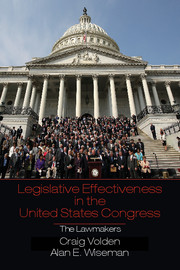Book contents
- Frontmatter
- Contents
- List of Tables and Figures
- Acknowledgments
- 1 Introduction
- 2 Measuring Legislative Effectiveness
- 3 The Keys to Majority-Party Effectiveness in Congress
- 4 A Tale of Three Minorities
- 5 Gridlock and Effective Lawmaking, Issue by Issue
- 6 The Habits of Highly Effective Lawmakers
- 7 The Future of Legislative Effectiveness
- References
- Index
- References
2 - Measuring Legislative Effectiveness
Published online by Cambridge University Press: 05 November 2014
- Frontmatter
- Contents
- List of Tables and Figures
- Acknowledgments
- 1 Introduction
- 2 Measuring Legislative Effectiveness
- 3 The Keys to Majority-Party Effectiveness in Congress
- 4 A Tale of Three Minorities
- 5 Gridlock and Effective Lawmaking, Issue by Issue
- 6 The Habits of Highly Effective Lawmakers
- 7 The Future of Legislative Effectiveness
- References
- Index
- References
Summary
Assessing the importance of floor decisionmaking is not easy. Ideally, the contribution of each stage of the legislative process to the ultimate legislative product could be determined, assigning weights to the various provisions of the legislation according to some measure of their policy significance. Generalizing about all legislation in a Congress by assigning weights to the individual measures according to their significance would be the first step in assessing the relative importance of the various stages of the process.
– Steven S. Smith. Call to Order: Floor Politics in the House and Senate (1989, p. 12)As the Congress came to a close, the lawmakers returned to their districts ready to claim credit for their accomplishments and to advertise the positions they had taken over the past two years. They would account for their actions and ask for voters’ support once again. Some would return home excited by the successes they had achieved through their sponsored legislation. Others would draw attention to broader issues and to their role in voting for or opposing the proposals of their colleagues.
While each had carried their constituents’ concerns to Capitol Hill a mere twenty months prior, Representatives Pomeroy (D-ND), Oberstar (D-MN), Kildee (D-MI), and McNulty (D-NY) returned from Congress in 2008 with marked differences in their proven effectiveness as lawmakers. Pomeroy and Oberstar had introduced the most legislation, with thirty-six and thirty-nine bills, respectively. Yet their portfolios met vastly different fates. Oberstar saw ten of his bills signed into law, while all but one of Pomeroy’s bills died in committee and none advanced to President Bush’s desk for his signature. Kildee and McNulty had more limited portfolios, introducing eleven and five bills, respectively; and they, too, had starkly different fortunes. By the end of the 110th Congress , more than half of the bills that Kildee introduced had been signed into law, whereas none of McNulty’s five bills had made it to the White House.
- Type
- Chapter
- Information
- Legislative Effectiveness in the United States CongressThe Lawmakers, pp. 14 - 59Publisher: Cambridge University PressPrint publication year: 2014
References
- 2
- Cited by



